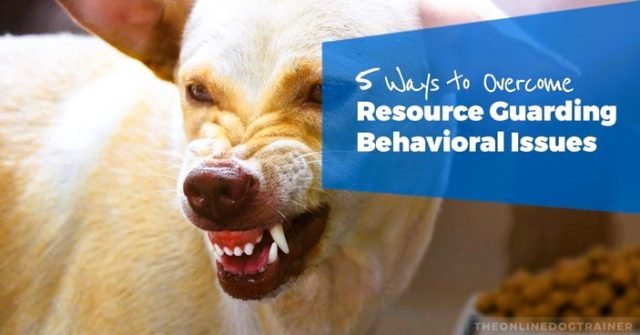To deal with dog guarding issues, establish clear boundaries and use positive reinforcement techniques. Consult a professional trainer for guidance.
Table of Contents
Dog-guarding issues can be challenging and stressful for pet owners. Dogs may guard food, toys, or even their favorite person, leading to aggressive behavior. Understanding the root cause of this guarding behavior is essential for addressing it effectively. Training your dog to feel secure and less possessive can help reduce these tendencies.
Positive reinforcement, such as rewarding good behavior, is crucial. Consistency and patience are key to reshaping your dog’s behavior. Professional guidance from a certified dog trainer can provide personalized strategies. Creating a safe and structured environment will help your dog feel more at ease, ultimately reducing guarding behavior.

Recognizing Guarding Behavior
Dogs may growl or snap. They often freeze and stare. Some hide their treasured items. This can include toys or food. Watch for tense body language. Dogs may show their teeth. They might bark aggressively. These are all signs of guarding.
Guarding can start with certain triggers. Food is a common trigger. Toys can also cause guarding. Strange people or animals can trigger it too. Stressful situations may make it worse. Past trauma can be a factor. Understanding triggers helps in managing the behavior. Recognize and avoid known triggers.
Understanding The Root Causes
Dogs are naturally protective. They guard their food, toys, and territory. This behavior is instinctive. It helps them survive in the wild. Domesticated dogs still have these instincts. They may guard items or people they love. Understanding this helps in managing guarding issues.
The environment can affect a dog’s guarding behavior. Crowded homes may cause stress. Stress can lead to guarding. Lack of resources can also be a factor. Dogs may guard food if they feel hungry. Proper training and a stable environment can help. A calm home can reduce guarding behaviors.
Evaluating Your Dog’s Environment
Dogs need a safe space to relax. A quiet corner or a cozy crate can work. Make sure it is away from high-traffic areas. This helps in reducing stress and anxiety. Dogs feel secure in their own spot. They are less likely to guard if they have a safe space.
Ensure your dog has easy access to food, water, and toys. Scatter resources around the house. This prevents guarding one specific spot. Multiple feeding areas can help. This reduces competition and stress. Balanced access to resources makes dogs feel secure.
Training Techniques
Use treats and praise to reward good behavior. Always give the treat right away after your dog does something good. This helps them understand what you want. Be consistent with your rewards. Your dog will learn faster with clear and consistent signals. Make sure the treats are small and healthy. This keeps your dog from getting too full or unhealthy. Positive reinforcement builds trust and a strong bond with your dog.
Start by showing your dog the object they guard from a distance. Gradually move closer, rewarding them with treats and praise. This helps them feel safe and relaxed around the object. Do not rush the process. Move at your dog’s pace. If they show signs of stress, take a step back. Repeat these steps daily until they stop guarding the object. Desensitization helps them understand that the object is not a threat.
Professional Assistance
Guarding issues in dogs can be serious. Biting or aggression are signs to seek help. Your dog might be stressed or fearful. A professional can help identify the problem. They also help find the best solution. Early help can prevent worse behavior.
Look for a certified trainer. They should have experience with guarding issues. Check their reviews and qualifications. Ask for references. A good trainer will use positive methods. Avoid trainers who use harsh tactics. Your dog’s safety is important. A qualified trainer can make a big difference.

Credit: theonlinedogtrainer.com
Implementing Management Strategies
Feed your dog in a quiet space. Use separate areas for multiple pets. This avoids competition and stress. Scheduled feeding times create a routine. Avoid leaving food out all day. This reduces guarding behavior. Remove food bowls after meals. This prevents guarding of empty bowls.
Limit the number of toys available at one time. Rotate toys to keep interest high. Store unused toys out of sight. This makes each toy feel special. Supervise playtime with new toys. This ensures fair play and reduces guarding. Teach your dog to trade toys. Offer a treat for the toy they guard.
Building Trust
Address dog guarding issues by establishing a routine and consistent boundaries. Reinforce positive behavior with rewards to build trust.
Consistent Routine
Dogs need a consistent routine to feel safe. Feed them at the same time daily. Walk them at regular intervals. Play and train them at set times. Routine builds trust and reduces stress.
Gentle Handling
Always use gentle handling with your dog. Speak in a calm voice. Avoid sudden movements. Pet them softly and reward good behavior with treats. Gentle handling helps dogs feel secure and less guarded.
Maintaining Progress
Make sure to have regular check-ins with your dog. This helps you monitor progress and adjust training if needed. Keep these check-ins consistent and positive. Use treats and praise to encourage good behavior. Never scold your dog during these sessions. Always focus on positive reinforcement.
Sometimes, you need to adjust your techniques. If one method does not work, try another. Always use gentle methods. Never use force or punishment. This can make guarding issues worse. Consult a professional trainer if needed. They can provide expert advice and guidance. Always be patient with your dog. Consistency and understanding are key to success.

Credit: yourdogsfriend.org
Conclusion
Addressing dog guarding issues requires patience and consistency. Use positive reinforcement to encourage desired behaviors. Understand your dog’s triggers and manage their environment. With time and effort, you can help your dog feel more secure. Implement these strategies and enjoy a happier, healthier relationship with your furry friend.








